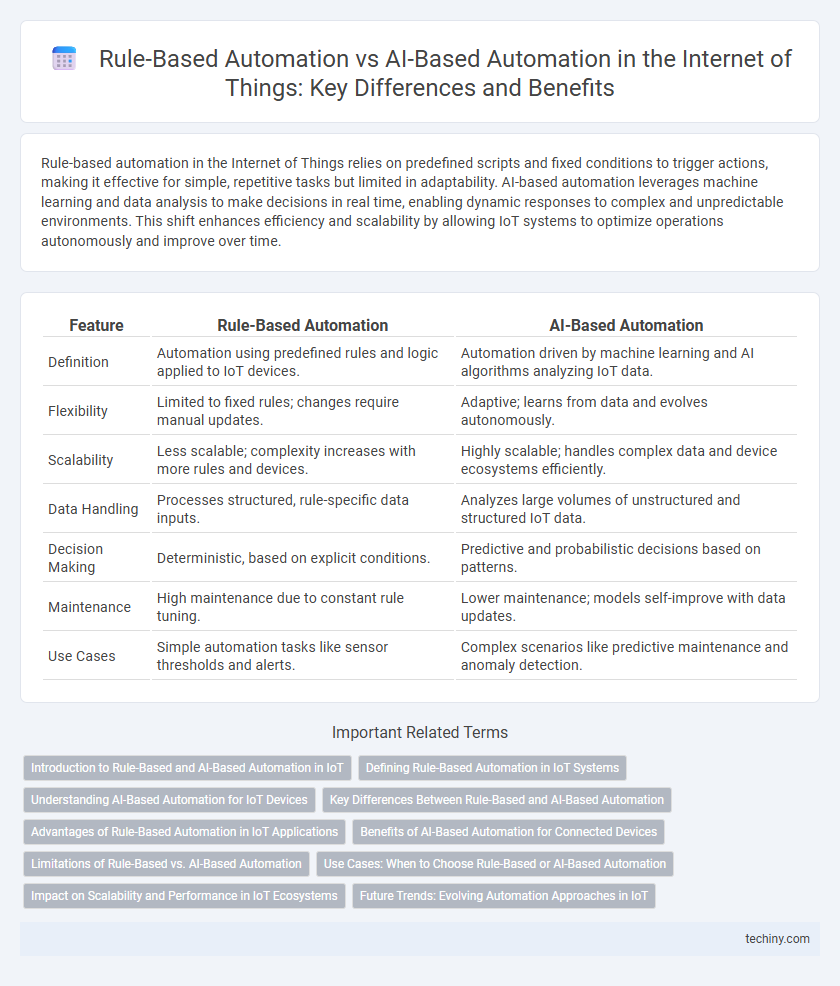Rule-based automation in the Internet of Things relies on predefined scripts and fixed conditions to trigger actions, making it effective for simple, repetitive tasks but limited in adaptability. AI-based automation leverages machine learning and data analysis to make decisions in real time, enabling dynamic responses to complex and unpredictable environments. This shift enhances efficiency and scalability by allowing IoT systems to optimize operations autonomously and improve over time.
Table of Comparison
| Feature | Rule-Based Automation | AI-Based Automation |
|---|---|---|
| Definition | Automation using predefined rules and logic applied to IoT devices. | Automation driven by machine learning and AI algorithms analyzing IoT data. |
| Flexibility | Limited to fixed rules; changes require manual updates. | Adaptive; learns from data and evolves autonomously. |
| Scalability | Less scalable; complexity increases with more rules and devices. | Highly scalable; handles complex data and device ecosystems efficiently. |
| Data Handling | Processes structured, rule-specific data inputs. | Analyzes large volumes of unstructured and structured IoT data. |
| Decision Making | Deterministic, based on explicit conditions. | Predictive and probabilistic decisions based on patterns. |
| Maintenance | High maintenance due to constant rule tuning. | Lower maintenance; models self-improve with data updates. |
| Use Cases | Simple automation tasks like sensor thresholds and alerts. | Complex scenarios like predictive maintenance and anomaly detection. |
Introduction to Rule-Based and AI-Based Automation in IoT
Rule-based automation in IoT relies on predefined if-then conditions to trigger specific actions, offering simplicity and predictability in device interactions. AI-based automation leverages machine learning algorithms and data analytics to enable adaptive, real-time decision-making based on evolving environmental inputs. Combining both approaches enhances IoT systems' efficiency by balancing structured commands with intelligent, autonomous responses.
Defining Rule-Based Automation in IoT Systems
Rule-based automation in IoT systems involves predefined if-then statements that trigger specific actions based on sensor data or device status, enabling predictable and straightforward control mechanisms. These rule sets allow IoT devices to respond to environmental changes without human intervention, ensuring consistent operation in scenarios like smart homes or industrial monitoring. While effective for simple tasks, rule-based automation lacks adaptability and cannot handle complex patterns or evolving conditions as AI-based automation can.
Understanding AI-Based Automation for IoT Devices
AI-based automation for IoT devices leverages machine learning algorithms and data analytics to enable real-time decision-making and adaptive responses, surpassing the static, predetermined actions of rule-based systems. This approach enhances predictive maintenance, optimizes energy consumption, and improves security by continuously learning from device data and environmental changes. The integration of AI enables IoT ecosystems to evolve autonomously, increasing efficiency and reducing human intervention.
Key Differences Between Rule-Based and AI-Based Automation
Rule-based automation relies on predefined, static rules to execute specific tasks in IoT systems, offering predictability and easy implementation but limited adaptability. AI-based automation leverages machine learning and data analytics to enable dynamic decision-making, continuous learning, and complex pattern recognition within connected devices. Key differences include flexibility, scalability, and the ability to handle unstructured data, where AI-based automation outperforms rule-based systems in evolving IoT environments.
Advantages of Rule-Based Automation in IoT Applications
Rule-based automation in IoT applications offers straightforward implementation, enabling devices to perform predefined actions based on specific triggers without requiring complex algorithms. This method ensures high reliability and predictability, as actions are explicitly programmed, reducing the risk of unexpected behavior. Rule-based systems also demand lower computational resources, making them ideal for cost-sensitive or resource-constrained IoT devices.
Benefits of AI-Based Automation for Connected Devices
AI-based automation enhances connected devices by enabling real-time data processing and adaptive decision-making, improving efficiency and responsiveness. It leverages machine learning algorithms to predict user behavior and detect anomalies, leading to proactive maintenance and enhanced security. Unlike rule-based systems, AI-driven automation continuously learns from data, optimizing performance and enabling smarter, context-aware interactions.
Limitations of Rule-Based vs. AI-Based Automation
Rule-based automation in the Internet of Things (IoT) is limited by its reliance on predefined rules, making it unable to adapt to dynamic environments or learn from new data. AI-based automation overcomes these constraints through machine learning and predictive analytics, enabling real-time decision-making and enhanced scalability. Consequently, AI-driven systems offer greater flexibility and efficiency in managing complex IoT networks compared to rigid rule-based frameworks.
Use Cases: When to Choose Rule-Based or AI-Based Automation
Rule-based automation excels in scenarios with well-defined, repetitive tasks such as industrial equipment monitoring or simple home automation, where predefined rules ensure consistent outcomes. AI-based automation is ideal for complex and dynamic environments like predictive maintenance or smart city traffic management, where machine learning models adapt to real-time data and improve over time. Selecting between these approaches depends on factors like the complexity of tasks, data variability, and the need for adaptability in Internet of Things (IoT) systems.
Impact on Scalability and Performance in IoT Ecosystems
Rule-based automation in IoT ecosystems offers predictable performance but struggles with scalability due to rigid, predefined conditions that limit adaptability to complex or evolving environments. AI-based automation enhances scalability by leveraging machine learning algorithms to process vast amounts of data, enabling dynamic decision-making that improves system responsiveness and efficiency. This adaptive intelligence significantly boosts performance in large-scale IoT deployments by optimizing resource allocation and minimizing latency through real-time analytics.
Future Trends: Evolving Automation Approaches in IoT
Rule-based automation in IoT relies on predefined conditions and static logic, limiting adaptability in complex environments, while AI-based automation leverages machine learning algorithms to enable dynamic decision-making and predictive analytics. Emerging trends indicate a shift towards hybrid models that integrate rule-based frameworks with AI capabilities to enhance scalability, efficiency, and contextual awareness in smart devices. This evolution supports real-time data processing and autonomous system optimization, driving the future of intelligent IoT ecosystems.
Rule-Based Automation vs AI-Based Automation Infographic

 techiny.com
techiny.com